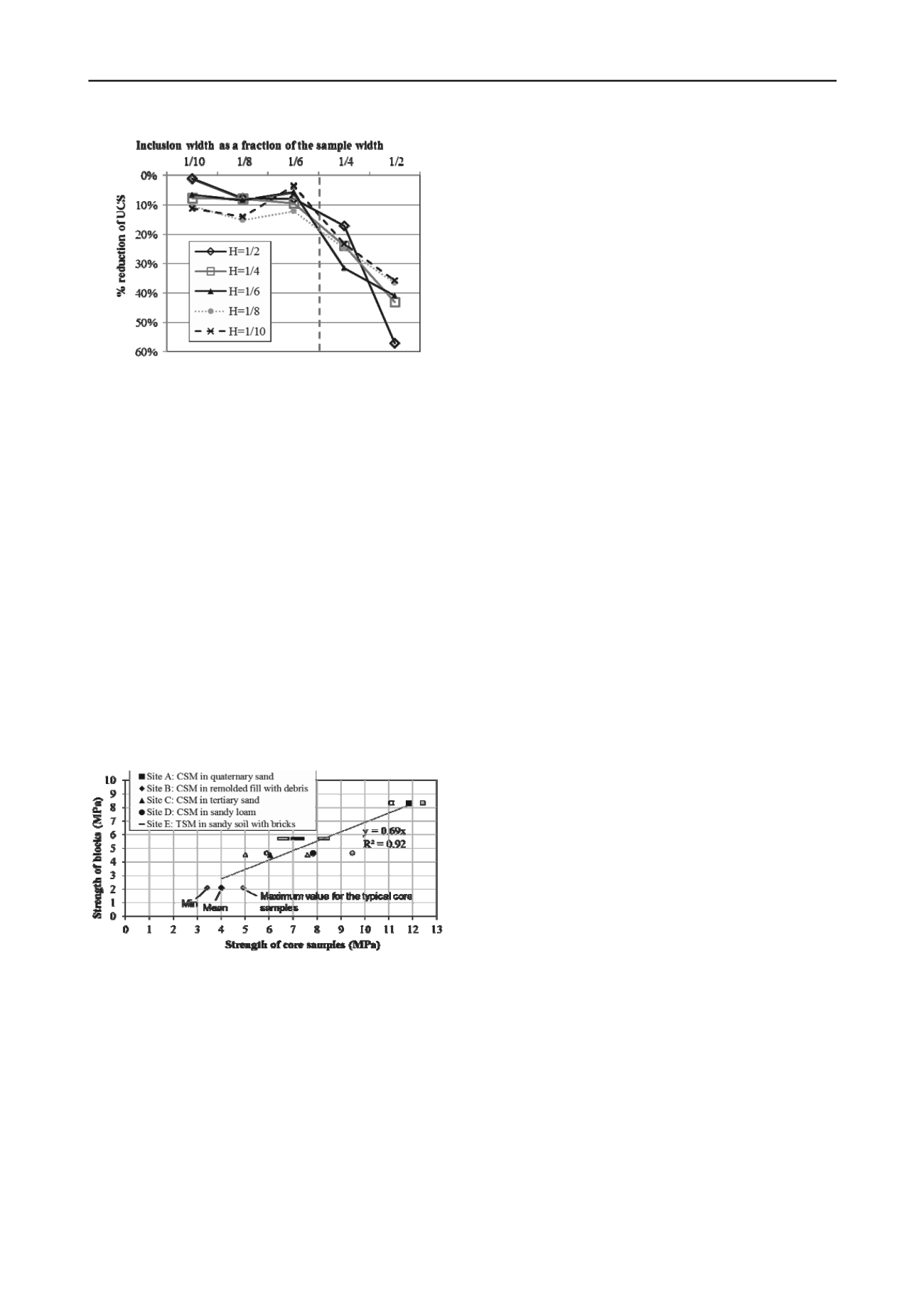
2468
Proceedings of the 18
th
International Conference on Soil Mechanics and Geotechnical Engineering, Paris 2013
- the determination of the X% lower quantile for DSM
material (in case of statistical calculation),
- the presence of the unmixed soft soil inclusions potentially
considering the rule of 1/6 (Ganne et al. 2010),
- the scale effect (with regard to the full-scale factor of 0.7),
- the possibility of 3D analysis,
- and the time effects (with the help of creep test or based on
experience with similar technique and soil conditions).
Figure 4. Influence of the dimensions of the soil inclusions on the UCS
of soil mix material. Results of 2D numerical simulations performed
with the help of the Universal Distinct Element Code UDEC of Itasca
®
.
Details of the model are available in Van Lysebetten et al. (2013). H is
the ratio between the height of the soil inclusion and the sample
diameter.
The curing and creep phenomena are currently investigated
within the framework of the BBRI ‘Soil Mix’ project. Indeed,
while SMWs were previously used only for temporary
excavation support, permanent retaining and bearing
applications with soil mix are increasingly applied in Belgium.
For the evolution of the UCS value with time, it is suggested to
consider the value of the UCS at 28 days as the value of
reference for the strength of the DSM material.
6 ACKNOWLEDGEMENTS
This research is financially supported by the Agency for
Innovation by Science and Technology of the Flemish Region
IWT (BBRI ‘Soil Mix’ project, 2009-2013).
4 INFLUENCE OF THE SCALE EFFECT
Apart from traditional core samples (with a diameter around 10
cm), large scale UCS tests were conducted on rectangular
blocks with approximately a square section, with a width
corresponding to the width of the in situ SMW (about half a
meter) and with a height approximately twice the width
(Vervoort et al. 2012). The results of all the tests performed in
KU Leuven are presented in Fig. 5 for various soil conditions
and different execution systems: the CSM and the TSM.
7 REFERENCES
BBRI. 2012a. Infofiche. Parois de type “Soil mix” de type 1 : parois
faites de colonnes.
BBRI information sheet 56.5,
, July
2012 (in Dutch and French).
BBRI. 2012b. Infofiche. Parois de type “Soil mix” de type 2 : parois
faites de panneaux.
BBRI information sheet 56.6,
July
2012 (in Dutch and French).
As observed in Fig. 5, a linear relationship is observed
between the test results obtained from the typical core samples
and the large rectangular blocks. Although there is a scatter in
the test results, the UCS of the full-scale blocks is about 70% of
the average UCS of the typical core samples. It is to note that
similar conclusion was observed for DSM columns in Japan
(CDIT 2002).
CDIT. Coastal Development Institute of Technology. 2002.
The Deep
Mixing Method – Principle, Design and Construction
. Edited by
CDIT, Japan. A. A. Balkema Publishers/Lisse/Abingdon/Exton
(PA)/Tokyo.
Denies, N. and Van Lysebetten, G. 2012. General Report – Session 4 –
SOIL MIXING 2 – DEEP MIXING.
International Symposium of
ISSMGE - TC211. Recent research, advances & execution aspects
of ground improvement works. N. Denies and N. Huybrechts (eds.).
31 May-1 June 2012, Brussels, Belgium
, Vol. I, pp. 87-124.
Denies, N., Huybrechts, N., De Cock, F., Lameire, B., Vervoort, A.,
Van Lysebetten, G. and Maertens, J. 2012. Soil Mix walls as
retaining structures – mechanical characterization.
International
Symposium of ISSMGE - TC211. Recent research, advances &
execution aspects of ground improvement works. 31 May-1 June
2012, Brussels, Belgium
, Vol. III, pp. 99-115.
DIN 4093:2012-08. Design of ground improvement – Jet grouting, deep
mixing or grouting. August 2012 (in German).
Eurosoilstab. 2002. Development of design and construction methods to
stabilise soft organic soils.
Design Guide Soft Soil Stabilisation
. EC
project BE 96-3177.
Figure 5. Scale effect: relationship between the results of UCS tests on
typical cylindrical core samples (10 cm diameter) and on large
rectangular blocks tested in KU Leuven (after Vervoort et al. 2012).
Ganne, P., Huybrechts, N., De Cock, F., Lameire, B. and Maertens, J.
2010. Soil mix walls as retaining structures – critical analysis of the
material design parameters,
International conference on
geotechnical challenges in megacities, June 07-10, 2010, Moscow,
Russia
, pp. 991-998.
Topolnicki, M. and Pandrea, P. 2012. Design of in-situ soil mixing.
International Symposium of ISSMGE - TC211. Recent research,
advances & execution aspects of ground improvement works. 31
May-1 June 2012, Brussels, Belgium
, Vol. III, pp. 309-316.
5 CONCLUSIONS
Based on the results of the BBRI ‘Soil Mix’ project, a Belgian
design methodology for the DSM structures is currently
developed. On the one hand to determine the UCS characteristic
value of the DSM material and on the other hand to design the
SMW as a retaining wall according to the requirements of the
Eurocode 7. According to the results presented in this paper, the
calculation of the UCS characteristic value should consider:
Van Lysebetten G., Vervoort A., Denies, N., Huybrechts, N., Maertens,
J., De Cock, F. and Lameire B. Numerical modeling of fracturing in
soil mix material.
International Conference on Installation Effects
in Geotechnical Engineering. March 24 – 27, 2013. Rotterdam. The
Netherlands
.
- the number of tested core samples,
- the possibility to use a statistical approach (based on the
cumulative curve) or an approach such as in the DIN,
Vervoort, A., Tavallali, A., Van Lysebetten, G., Maertens, J., Denies,
N., Huybrechts, N., De Cock, F. and Lameire, B. 2012. Mechanical
characterization of large scale soil mix samples and the analysis of
the influence of soil inclusions.
International Symposium of
ISSMGE - TC211. Recent research, advances & execution aspects
of ground improvement works. 31 May-1 June 2012, Brussels,
Belgium
, Vol. III, pp. 127-135.


